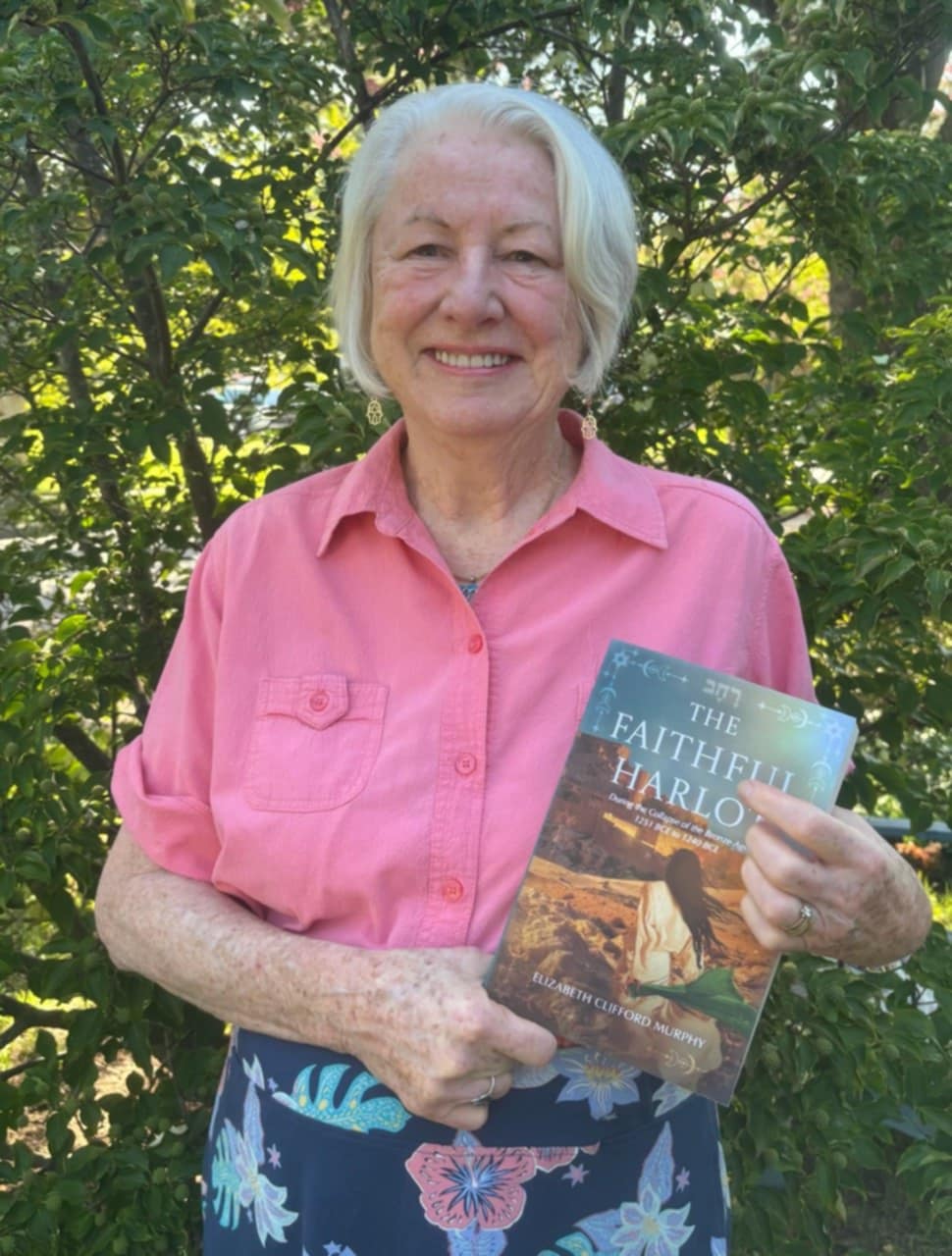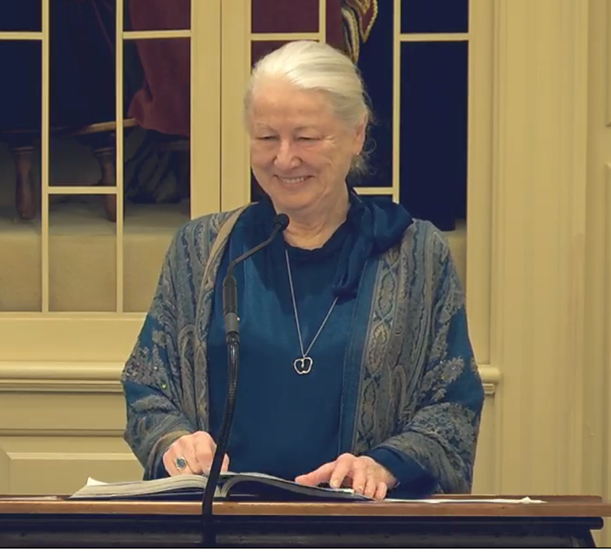
Elizabeth fled from her rigid, all-girl's Catholic high school, where no doubts were permitted, to Sheepshead Bay H.S. with a cosmopolitan population of 5,000, in her working-class neighborhood. Many storekeepers and residents either hid or proudly brandished the numbers that Nazis had tattooed onto their forearms. One of them, the baker next door to the library where Elizabeth worked during high school, would sell her an egg-glazed soft roll only when she mastered the gutteral pronunciation of challah. As one of only two non-Jews working in her holy of holies (the Kings Bay Branch of the Brooklyn Public Library), Elizabeth devoured children's books, Jewish best sellers, history books especially about the recent Holocaust, and The New York Times. As secret acts of penance, she shelved all the books in perfect Dewey Decimal order for the sake of the souls in Purgatory. Her home life was tough. She graduated from SBHS after her junior year, attended Brooklyn College, and lived in a sublet Flatbush apartment. She and Her Episcopalian roommate and she kept a Kosher home, served on a board as youth advisors at Trinity Church on Wall Street, and became part of an intellectual, ecumenical group of working-class activists against racism, sexism, and the war in Vietnam.
At 18, working by day as a Manhattan corporate secretary and attending Brooklyn College at night, Elizabeth wrote several proposals to the National Institute of Mental Health (NIMH), YMCA, Maimonides Hospital, and other institutions, winning grants to co-found and co-direct (with the Methodist Rev. John Messerschmitt) the long-lived Laughing Tiger Day Camp for Mentally Ill Children in Sunset Park. (Can you imagine a name like that today?) Elizabeth spent her 19th summer in Selma, Alabama, volunteering at Good Samaritan Hospital, a segregated Catholic medical mission. On her return to Brooklyn, she became engaged to a popular co-member of the college yearbook staff, Joe, a religiously observant grandson of an Orthodox Ashkenazi rabbi. They attended Conservative shul services and completed a conversion course together at Temple Emanu-El across from Central Park before ending their long relationship.
Elizabeth taught reading and life skills to adults for the YMCA and NYC Board of Ed before becoming managing editor of James Dunnigan's history magazine and games publishing company where she wrote a monthly column for Moves magazine. She co-authored various games and published some short stories. She ghost-wrote articles and speeches for her professors and did consulting work for St. Martin's Press, Scott-Foresman, Macmillan, and others while also attending night classes at the NYU Grad School of Business and the New School. She married a brilliant, abusive, alcoholic novelist in 1974, and in 1976 she became the single mother of their one-year-old son, Andy.
Working as a senior editor of anthologies and grammar texts at Harcourt Brace Jovanovich, Elizabeth met and married multi-talented artist Thomas Murphy. They moved upstate and enjoyed acting together in community theater. After their second son had entered preschool, Elizabeth earned a master's from SUNY New Paltz in order to obtain a teaching license. Meanwhile, she taught English for Marist College and worked for five years as a basic education and GED teacher, paralegal, and corrections officer in a federal men’s prison (Otisville), while Tom worked as a commercial artist and later as a teacher. She spent the next 24 years teaching English in Minisink Valley Middle School, foster parenting, attending either an Episcopal or Roman Catholic Church, and writing two more unpublished novels (one of which [Horatio's Song, a YA prequel to Hamlet] was good). Under her leadership as its Executive Director, Pike County Arts and Crafts won the 2007 Pennsylvania Governor's Award for the Best Creative Community, and Elizabeth was one of the people pictured on the cover of Milford Magazine as among the "100 Most Influential People" in the NY-NJ-PA tri-state area.
After several years of taking care of Tom's and Elizabeth's aging parents in their last years, the two Murphys traveled extensively, especially to Ireland. They moved to Norfolk, VA, to help with their two oldest grandchildren while Andy, USCG, was deployed. Post-retirement in Norfolk, Tom and Elizabeth worked as Court Appointed Special Advocates for children (CASA) and un-retired to teach again.
Elizabeth was finally sure on October 27, 2018, that she was a Jew by choice. She attended Torah study twice a week, learned Biblical Hebrew, and handed the Rabbi a copy of her 50-year-old conversion course-completion certificate. Rabbi Roz and Cantor Jen had her practice and study Judaism for another year before she could plunge into the mikvah, appear before the Beit Din, and take the Hebrew name Morah Elesheva bat Sarah v'Avraham. Sometimes she gives sermons and other presentations, leads Torah Study groups, and occasionally teaches and serves as a judge in the beit din. She's involved with the work of the Jewish Community Center of Tidewater and local soup kitchens and food pantries. Most of her hours are spent writing and practicing benign neglect of her gardens.
COVID-19 provided Elizabeth the opportunity to research some of her long unanswered "How comes?" The most pressing ones were "How come we should trust the Bible as history?” and “Who wrote it, why, and when?" The temple's leader of Torah Study, Dr. David Metzger, and the works of Richard Elliot Friedman inspired her to write The Harlot and the Mouse, a series of at least two Biblical/historical novels, the first of which was published by Köehler Books when she and Tom were 76.
Her first published book, The Faithful Harlot, is set during the time of the Exodus(es). The world-altering seventh century BCE setting of her second novel has the working title Huldah the Mouse. It arose from the question, "How come everyone assumes the author of the female-supportive book of Deuteronomy was a man?" Elizabeth shows how a little Biblical prophetess, characterized as a dwarf (huldah is Hebrew for "mouse") secretly writes the basis for the Bible--the Code of Laws “discovered” in 621 BCE that scholars now attribute to an unknown Deuteronomist Historian. The third novel of the series will follow a mature Huldah and her best pagan friend--another brilliant woman, a famous 6th-7th century BCE Assyrian priestess/princess, Addagoppe, daughter of Ashurbanipal and mother of Nabonidus. This work-in-progress is set during the Babylonian Captivity in which Huldah authors and oversees the compilation of seven books of the Bible, the most significant and influential work ever written.

